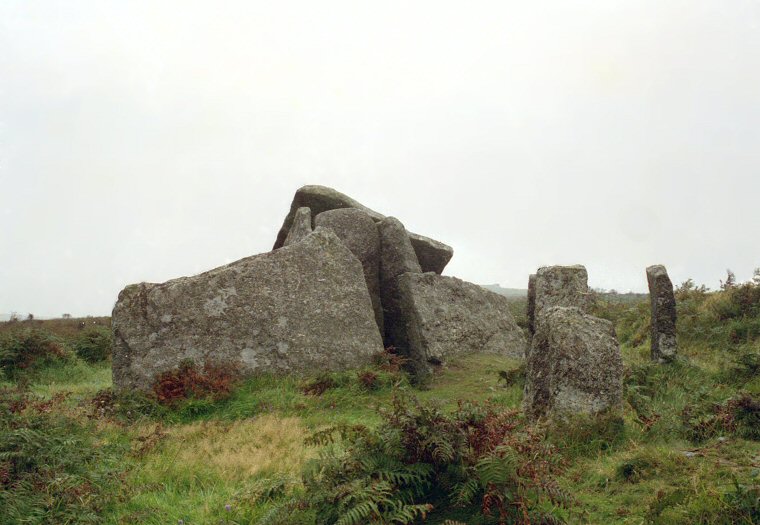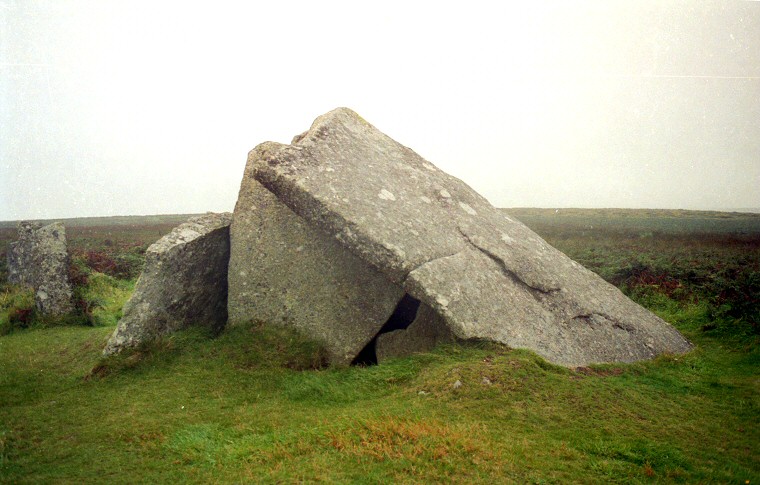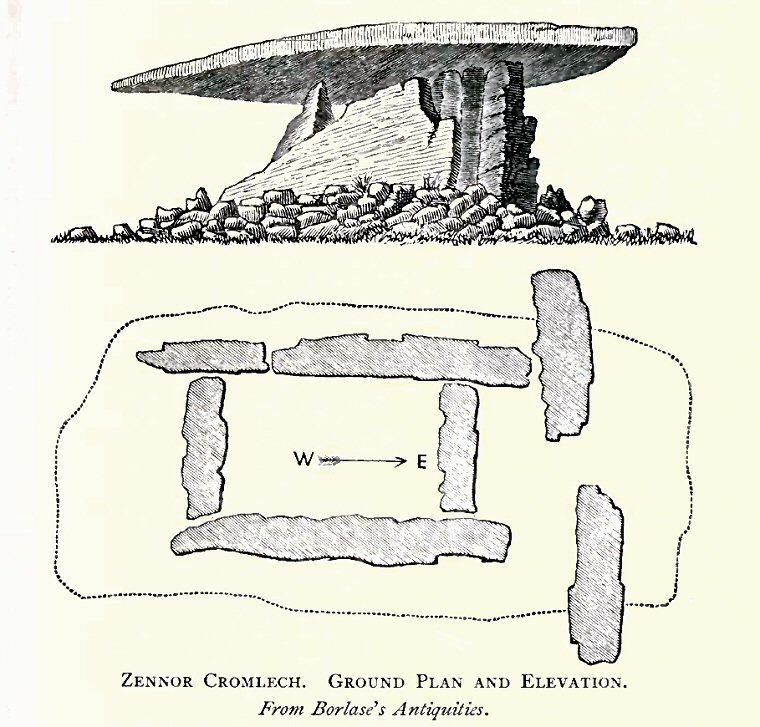
Front view of Zennor Quoit showing the massive facade stones on either side of the chamber.
Zennor Quoit is situated towards the north-western end of the Amalveor Downs on a slight ridge of land below the higher ground of Zennor Hill to the northwest and towards the top of a steep sided valley whose stream flows northwest to the sea just over a mile away at Pendour Cove. The stones of this chambered
tomb are quite difficult to find and the site is probably most easily reached by following footpaths south
from the B3306 road.
The scheduling information for Zennor Quoit records the site as a type of monument known as an Entrance Grave (also referred to as a Scillonian Chamber Tomb), a dozen or so of which are found on the western tip of Cornwall but which are found in considerable numbers on the Isles of Scilly 35 miles (60 km) to the southwest. However, local expert Craig Weatherhill argues convincingly that Zennor is in fact a Penwith Chamber Tomb, a type of portal dolmen of which a dozen exist in Cornwall with a concentration of seven remaining monuments on Land's End including Chun Quoit and the famous Lanyon Quoit, both located less than 5 miles (8 km) to the southwest.
Whichever interpretation is correct, this Neolithic tomb consists of a rectangular box structure formed by five slabs that create a chamber measuring about 2 metres by 1.2 metres internally and standing about 2.4 metres high. The side slabs extend to the east to form a small ante-chamber behind a pair of facade stones set perpendicularly to the main chamber, a gap between the facade stones forming the entrance (in the middle of the photograph above). The capstone which is just over 5 metres long, 3 metres wide and weighs about 10 tons formerly covered the whole structure but has now has partly collapsed towards the north. The chamber would originally have been set within a stone cairn measuring about 13 metres in diameter and although this has mostly disappeared it was recorded in 1769 by Dr. William Borlase who illustrated the remains of the cairn and the tomb when the capstone was still intact (drawing at the bottom of page).
It a descendant of Borlase we have to thank for the continuing existence of Zennor Quoit, as recounted by James Halliwell in 1861 - 'The following paragraph appeared in the Cornish Telegraph of Sept. 4th, 1861, - "Zennor Quoit, one of our local antiquities, has recently had a narrow escape... A farmer had removed a part of one of the upright pillars, and drilled a hole into the slanting quoit, in order to erect a cattle-shed, when news of the vandalism reached the ears of the Rev. W. Borlase, vicar of Zennor, and for five shillings the work of destruction was stayed, the vicar having thus strengthened the legend that the quoit cannot be removed"'.
The newspaper reports suggests that the capstone (the 'slanting quoit') had already fallen by this time but the farmers attempt at remodeling and the 'excavation' of paving slabs within the main chamber with explosives in 1881 means it is remarkable that the site still exists at all. The five small upright stones just beyond the entrance to the tomb (the stones to the right in the photograph above) are thought to be part of the aborted cowshed.
At various times cremated bones, flints, Neolithic pottery and a perforated whetstone have been found within the chamber. The whetstone has been dated to the Bronze Age which suggests there was an interest in, if not continuing use of, the tomb extending over several hundred years.
In my original notes for the site I wrote:
'The site may look to be in a sad state of disrepair, especially on a wet, windy day, but this could be said to add to its beauty and melancholy, and it is still well worth a visit. Like many other sites legend says it was built by a giant, hence its other name of Giants Quoit and also that the stones are unmovable, or if they are moved they will return to the hillside on their own. Nearby, the church at Zennor contains a 15th century bench-end carved into the shape of a mermaid that is claimed to have visited the village and fallen in love with the churchwarden's son. The two of them are then said to have returned to the sea, where the unfortunate lad can still be heard singing beneath the waves.'
The name Zennor comes from the female Cornish saint, Sinar, to whom the village church is dedicated.
The scheduling information for Zennor Quoit records the site as a type of monument known as an Entrance Grave (also referred to as a Scillonian Chamber Tomb), a dozen or so of which are found on the western tip of Cornwall but which are found in considerable numbers on the Isles of Scilly 35 miles (60 km) to the southwest. However, local expert Craig Weatherhill argues convincingly that Zennor is in fact a Penwith Chamber Tomb, a type of portal dolmen of which a dozen exist in Cornwall with a concentration of seven remaining monuments on Land's End including Chun Quoit and the famous Lanyon Quoit, both located less than 5 miles (8 km) to the southwest.
Whichever interpretation is correct, this Neolithic tomb consists of a rectangular box structure formed by five slabs that create a chamber measuring about 2 metres by 1.2 metres internally and standing about 2.4 metres high. The side slabs extend to the east to form a small ante-chamber behind a pair of facade stones set perpendicularly to the main chamber, a gap between the facade stones forming the entrance (in the middle of the photograph above). The capstone which is just over 5 metres long, 3 metres wide and weighs about 10 tons formerly covered the whole structure but has now has partly collapsed towards the north. The chamber would originally have been set within a stone cairn measuring about 13 metres in diameter and although this has mostly disappeared it was recorded in 1769 by Dr. William Borlase who illustrated the remains of the cairn and the tomb when the capstone was still intact (drawing at the bottom of page).
It a descendant of Borlase we have to thank for the continuing existence of Zennor Quoit, as recounted by James Halliwell in 1861 - 'The following paragraph appeared in the Cornish Telegraph of Sept. 4th, 1861, - "Zennor Quoit, one of our local antiquities, has recently had a narrow escape... A farmer had removed a part of one of the upright pillars, and drilled a hole into the slanting quoit, in order to erect a cattle-shed, when news of the vandalism reached the ears of the Rev. W. Borlase, vicar of Zennor, and for five shillings the work of destruction was stayed, the vicar having thus strengthened the legend that the quoit cannot be removed"'.
The newspaper reports suggests that the capstone (the 'slanting quoit') had already fallen by this time but the farmers attempt at remodeling and the 'excavation' of paving slabs within the main chamber with explosives in 1881 means it is remarkable that the site still exists at all. The five small upright stones just beyond the entrance to the tomb (the stones to the right in the photograph above) are thought to be part of the aborted cowshed.
At various times cremated bones, flints, Neolithic pottery and a perforated whetstone have been found within the chamber. The whetstone has been dated to the Bronze Age which suggests there was an interest in, if not continuing use of, the tomb extending over several hundred years.
In my original notes for the site I wrote:
'The site may look to be in a sad state of disrepair, especially on a wet, windy day, but this could be said to add to its beauty and melancholy, and it is still well worth a visit. Like many other sites legend says it was built by a giant, hence its other name of Giants Quoit and also that the stones are unmovable, or if they are moved they will return to the hillside on their own. Nearby, the church at Zennor contains a 15th century bench-end carved into the shape of a mermaid that is claimed to have visited the village and fallen in love with the churchwarden's son. The two of them are then said to have returned to the sea, where the unfortunate lad can still be heard singing beneath the waves.'
The name Zennor comes from the female Cornish saint, Sinar, to whom the village church is dedicated.

Zennor Quoit - looking south over the collapsed capstone and side of the chamber. The facade stone to the left has had its top sliced off, this was presumably done during the attempt to use stone from the monument in the construction of a cow shed.

Illustration of Zennor Quoit by William Borlase 1769, reproduced by William Copeland Borlase - his great-great-grandson, in his own book - Naenia Cornubiae in 1872. The dotted line in the lower drawing represents the outline of the capstone.
Site Visits / Photographs:
August 1997.
References:
Borlase, W. 1769. Antiquities, Historical and Monumental of the County of Cornwall. London:
Borlase, W. C. 1872. Naenia Cornubiae - A Descriptive Essay. London: Longmans, Green, Reader and Dyer.
Cope, J. 1998. The Modern Antiquarian. A Pre-Millennial Odyssey through Megalithic Britain. London: Thorsons.
Cotton, W. 1827. Illustrations of Stone Circles, Cromlechs ... in the West of Cornwall. London: James Moyes.
Daniel, G. 1958. The Megalith Builders of Western Europe. London: Hutchinson and Co.
Dyer, J. 1981. The Penguin Guide to Prehistoric England and Wales. London: Penguin Books Ltd.
Hawkes, J. 1986. The Shell Guide to British Archaeology. London: Michael Joseph Ltd.
Halliwell, J. O. 1861. Rambles in Western Cornwall. London: John Russell Smith.
Joussaume, R. 1988. Dolmens For The Dead. Megalith Building throughout the World. Book Club Associates.
Lynch, F. 1997. Megalithic Tombs and Long Barrows in Britain. Princes Risborough: Shire Publications Ltd.
Megaw, J. and Simpson, D. 1979. Introduction to British Prehistory. Leicester University Press.
Room, A. 2003. The Penguin Dictionary of British Place Names. London: Penguin Books.
Weatherhill, C. 1981. Belerion. Ancient Sites of Land's End. Penzance: Alison Hodge.
Weatherhill, C. 1985. Cornovia. Ancient Sites of Cornwall & Scilly. Penzance: Alison Hodge.
The National Heritage List for England Number: 1004640. PastScape Monument No: 423294
Historic England Research Records Hob Uid: 423294. Cornwall & Scilly HER Number: 36098